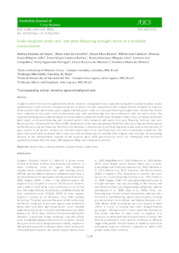Grain sorghum under pre- and post-flowering drought stress in a semiarid environment.
Grain sorghum under pre- and post-flowering drought stress in a semiarid environment.
Autoria: SOUZA, A. A. de; CARVALHO, A. J. de; BASTOS, E. A.; CARDOSO, M. J.; JÚLIO, M. P. M.; BATISTA, P. S. C.; JÚLIO, B. H. M.; CAMPOLINA, C. V.; PORTUGAL, A. F.; MENEZES, C. B. de; OLIVEIRA, S. M. de
Resumo: Sorghum is one of the most drought-tolerant cereals. However, strong water stress, especially during the reproductive phase, causes significant grain yield reduction. Drought events are common in second crops planted after soybean harvest in Brazil. The objective of the present study was to assess grain sorghum hybrids grown under pre- and post-flowering drought stress. Twenty-five hybrids were subjected to two water stress environments (pre- and post-flowering) and one environment with non-water stress. The experimental design was a split plot based on a randomized complete block with three replicates. Water stress pre-flowering reduced plant height, accelerated flowering, and increased panicle index compared with water stress post-flowering. Both pre- and postflowering stress reduced yield, by 45% and 48%, respectively. Grain mass was greatly affected by stress occurring post-flowering but not by that occurring pre-flowering. Therefore, the reduction in yield caused by pre-flowering stress is due more to the reduction of grain number in the panicle, whereas the reduction when stress occurs post-flowering is due more to reduction in grain size. The plant chlorophyll index decreased when stress occurred pre-flowering and reverted after irrigation had resumed, demonstrating recovery in the photosynthetic capacity of the sorghum plant. With post-flowering stress, the chlorophyll index decreased significantly 30 days after the stress, affecting grain filling, with consequent yield loss.
Ano de publicação: 2021
Tipo de publicação: Artigo de periódico
Unidade: Embrapa Meio-Norte
Observações
1 - Por padrão são exibidas publicações dos últimos 20 anos. Para encontrar publicações mais antigas, configure o filtro ano de publicação, colocando o ano a partir do qual você deseja encontrar publicações. O filtro está na coluna da esquerda na busca acima.
2 - Para ler algumas publicações da Embrapa (apenas as que estão em formato ePub), é necessário ter, no celular ou computador, um desses softwares gratuitos. Sistemas Android: Google Play Livros; IOS: iBooks; Windows e Linux: software Calibre.
Acesse outras publicações
Acesse a Base de Dados da Pesquisa Agropecuária (BDPA) para consultar o acervo completo das bibliotecas da Embrapa.

